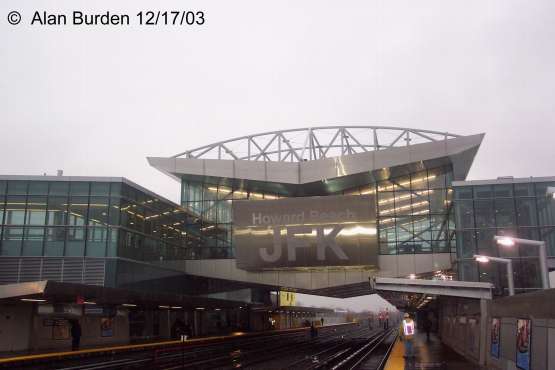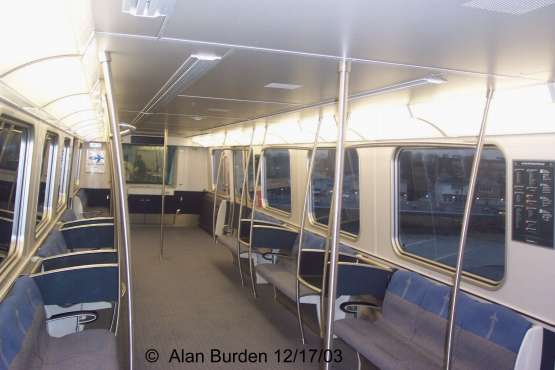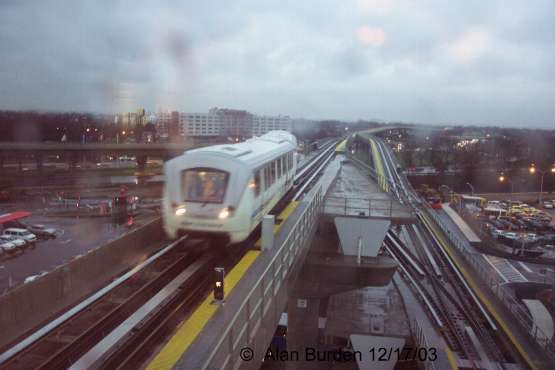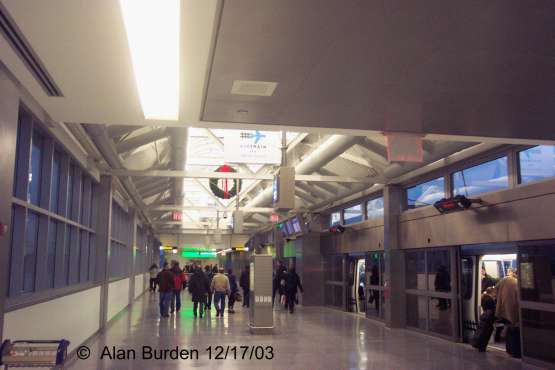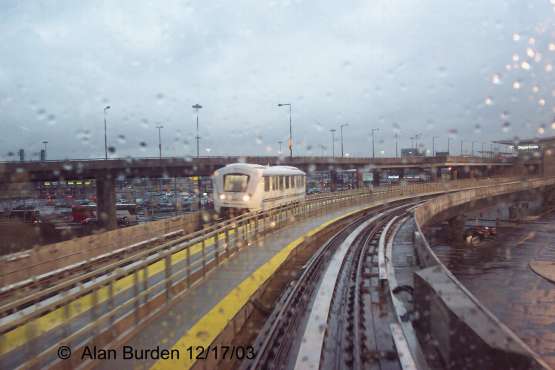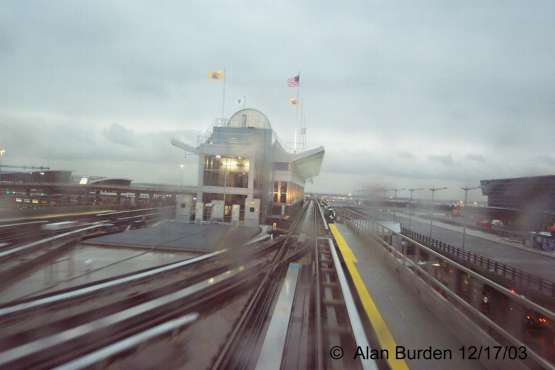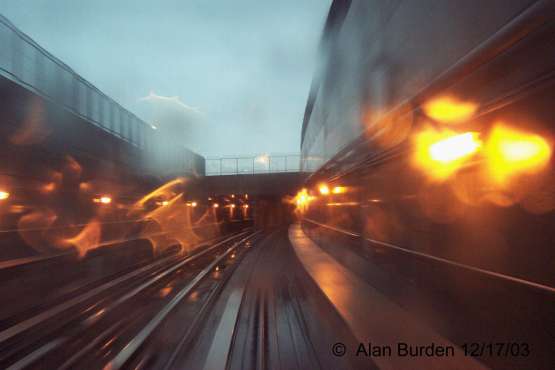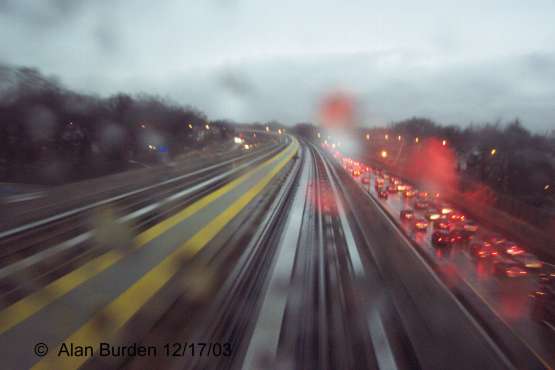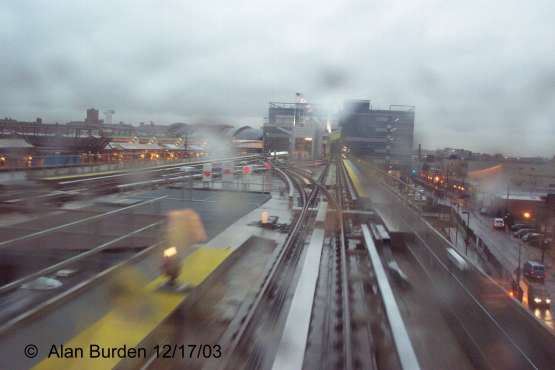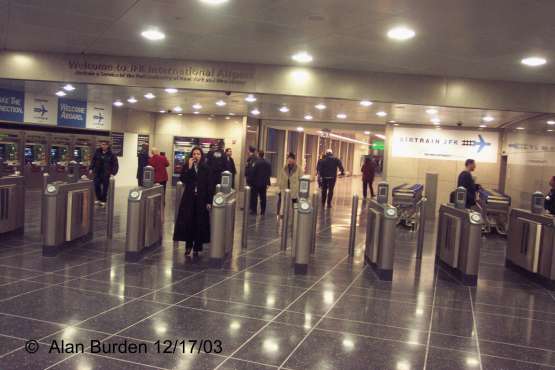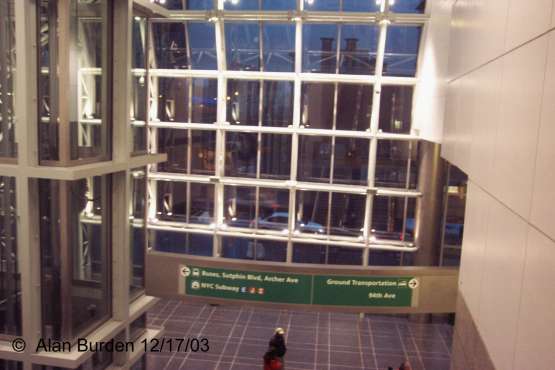Well at long last the JFK Airtrain opened for business today at 2:00 PM. For the first day, until midnight tonight, they were offering free rides. So I decided to take advantage of their generosity. I setout from midtown Manhattan on a Far Rockaway bound A train.
Upon arrival at the Howard Beach station, one finds a very seamless transfer from the subway to the upper level and the JFK Airtrain station. Escalators and elevators await arriving passengers from both subway platforms at the Howard Beach station. The new upper level is sleek and modern and under normal circumstances, one simply swipes your MetroCard and the five-dollar fare is deducted at the turnstiles that separate the subway concourse from the Airtrain concourse. There are plenty of Metrocard machines, along with a staffed window to pay at, should you need to increase the amount of money on your Metrocard.
Once on board the automated two-car train, you are quickly and quietly whisked from station to station. The first stop on this loop is Station B (Lefferts Blvd) and the long-term parking lots. Station A was the Howard Beach station. Shortly after leaving Station B, the train storage area and shops are passed on the left side of the train.
Moving on, just prior to the next station, this line is joined by the line from Jamaica. Trains from both lines stop at Station C (Federal Circle). Here one can find hotel shuttles & rental cars. From here we proceed to the airport terminals themselves.
The trains from Jamaica and Howard Beach run around an outer loop counter-clockwise, while a terminals only train runs clockwise around the inner loop. Anyone only wishing to move from one terminal to another can use the less crowded inner loop, which only runs (at least right now) with one-car trains. All trains make stops at all terminals. Terminals 1, 4, and 7 have their own stations, while terminals 2 & 3 share a station, as do terminals 5 & 6, and 8 & 9.
After making the loop, I disembarked when the train returned to Station C. Station C by the way is a split level station, with inbound cars stopping on the uppermost level, while outbound trains stop at the middle level. The lower level of course leads to the hotel shuttles and the rental cars.
Aside from wanting to see the inside of this station, I needed to detrain here if I wished to go to the Jamaica station. The train that I had been on would be returning to Station A/Howard Beach from here. After exploring this station for a few minutes, I then boarded an inbound train from Jamaica, so I could run around the airport a second time.
After the two tracks return to the same level upon leaving this station, they gradually descend into a short tunnel under a few airport roads. This is the system’s only tunnel. As we exit the tunnel and once again climb above grade level there are a few switches that connect to a short track. This short track in turn then connects to the inner loop, to allow trains to be added and taken off the inner loop.
I once again rode around the terminal loop and returned to Station C a second time. This time however I remained on the train for the run out to Jamaica. Shortly after leaving this station the train reaches the Van Wyck Expressway, where the tracks run on an elevated structure in the center median of the highway. At 4:30 PM, the Van Wyck was of course the typical parking lot that it is during rush hour. I of course was streaking by all the stopped cars & trucks at close to 50 MPH.
Less than 10 minutes later, the train was slowing for the curve into the Jamaica station. This station without a doubt is the crown jewel in the system. A huge glass wall of windows three stories high is at one end of the station. There is a direct connection to the LIRR via an elevated walkway that connects to one of the LIRR’s overhead walkways. At present though, one must go outside to connect to the subway. Hopefully this will be fixed soon, as with today rain, I for one would not want to have to lug my luggage out in the rain to connect.
Again Metrocard machines abound here, so that passengers can pay their fare for the Airtrain. There is also a LIRR ticket machine here for those wishing to take the LIRR home.
A short ride on the E train with a connection to the #7 train, and I was back home. Total cost to me for today $4.00 thanks to the free ride on the Airtrain. Starting tomorrow this same ride will cost 14 bucks.
A few other observations: The cars are roomy, brightly lit, and there are some seats. There is no doubt however that they were designed by and large for standees though. There are a few places that one can put luggage if you like, but most people seemed to keep their bags at their feet. The trains were quite busy today, in part due to a fair number of railfans, like myself. There was however a fair amount of passengers that were obviously headed to a plane, as they were loaded down with suitcases.
Since the system is automated, there are no signals to control spacing of trains. There are however dwarf sized signals at the switches, but they are not typical RR signals at all. While each signal consists of three aspects, like the typical subway signals, the lights are not red, green, & yellow. Instead the top two aspects display a white arrow indicating the direction that the switch is set for. The bottom aspect is red to indicate that either the switch is in motion or it is not safe to proceed for other reasons.
This signaling permits one of the bigger oddities that I found on the system. When I boarded at Station A, there were two trains in the station. I boarded the train on the left, since it was less crowded than the train on the right. The train on the right however would be the first to leave. As the trains leave the station there is a typical X crossover between the two tracks. Unlike a typical interlock though, which would require both the left and the right switches to operate together, the Airtrain does not have this requirement.
I could clearly see the that the switch in front of my train was set to reverse, so that my train would crossover to the outbound track, even though it’s counterpart was still in the normal position. Not only was the counterpart switch set to norm; it was busy handling the other outbound train. So our signal was showing a red aspect. Once the other train had cleared the counterpart, and placed a little distance between my train, we were allowed to proceed.
Upon arrival at the Howard Beach station, one finds a very seamless transfer from the subway to the upper level and the JFK Airtrain station. Escalators and elevators await arriving passengers from both subway platforms at the Howard Beach station. The new upper level is sleek and modern and under normal circumstances, one simply swipes your MetroCard and the five-dollar fare is deducted at the turnstiles that separate the subway concourse from the Airtrain concourse. There are plenty of Metrocard machines, along with a staffed window to pay at, should you need to increase the amount of money on your Metrocard.
Once on board the automated two-car train, you are quickly and quietly whisked from station to station. The first stop on this loop is Station B (Lefferts Blvd) and the long-term parking lots. Station A was the Howard Beach station. Shortly after leaving Station B, the train storage area and shops are passed on the left side of the train.
Moving on, just prior to the next station, this line is joined by the line from Jamaica. Trains from both lines stop at Station C (Federal Circle). Here one can find hotel shuttles & rental cars. From here we proceed to the airport terminals themselves.
The trains from Jamaica and Howard Beach run around an outer loop counter-clockwise, while a terminals only train runs clockwise around the inner loop. Anyone only wishing to move from one terminal to another can use the less crowded inner loop, which only runs (at least right now) with one-car trains. All trains make stops at all terminals. Terminals 1, 4, and 7 have their own stations, while terminals 2 & 3 share a station, as do terminals 5 & 6, and 8 & 9.
After making the loop, I disembarked when the train returned to Station C. Station C by the way is a split level station, with inbound cars stopping on the uppermost level, while outbound trains stop at the middle level. The lower level of course leads to the hotel shuttles and the rental cars.
Aside from wanting to see the inside of this station, I needed to detrain here if I wished to go to the Jamaica station. The train that I had been on would be returning to Station A/Howard Beach from here. After exploring this station for a few minutes, I then boarded an inbound train from Jamaica, so I could run around the airport a second time.
After the two tracks return to the same level upon leaving this station, they gradually descend into a short tunnel under a few airport roads. This is the system’s only tunnel. As we exit the tunnel and once again climb above grade level there are a few switches that connect to a short track. This short track in turn then connects to the inner loop, to allow trains to be added and taken off the inner loop.
I once again rode around the terminal loop and returned to Station C a second time. This time however I remained on the train for the run out to Jamaica. Shortly after leaving this station the train reaches the Van Wyck Expressway, where the tracks run on an elevated structure in the center median of the highway. At 4:30 PM, the Van Wyck was of course the typical parking lot that it is during rush hour. I of course was streaking by all the stopped cars & trucks at close to 50 MPH.
Less than 10 minutes later, the train was slowing for the curve into the Jamaica station. This station without a doubt is the crown jewel in the system. A huge glass wall of windows three stories high is at one end of the station. There is a direct connection to the LIRR via an elevated walkway that connects to one of the LIRR’s overhead walkways. At present though, one must go outside to connect to the subway. Hopefully this will be fixed soon, as with today rain, I for one would not want to have to lug my luggage out in the rain to connect.
Again Metrocard machines abound here, so that passengers can pay their fare for the Airtrain. There is also a LIRR ticket machine here for those wishing to take the LIRR home.
A short ride on the E train with a connection to the #7 train, and I was back home. Total cost to me for today $4.00 thanks to the free ride on the Airtrain. Starting tomorrow this same ride will cost 14 bucks.
A few other observations: The cars are roomy, brightly lit, and there are some seats. There is no doubt however that they were designed by and large for standees though. There are a few places that one can put luggage if you like, but most people seemed to keep their bags at their feet. The trains were quite busy today, in part due to a fair number of railfans, like myself. There was however a fair amount of passengers that were obviously headed to a plane, as they were loaded down with suitcases.
Since the system is automated, there are no signals to control spacing of trains. There are however dwarf sized signals at the switches, but they are not typical RR signals at all. While each signal consists of three aspects, like the typical subway signals, the lights are not red, green, & yellow. Instead the top two aspects display a white arrow indicating the direction that the switch is set for. The bottom aspect is red to indicate that either the switch is in motion or it is not safe to proceed for other reasons.
This signaling permits one of the bigger oddities that I found on the system. When I boarded at Station A, there were two trains in the station. I boarded the train on the left, since it was less crowded than the train on the right. The train on the right however would be the first to leave. As the trains leave the station there is a typical X crossover between the two tracks. Unlike a typical interlock though, which would require both the left and the right switches to operate together, the Airtrain does not have this requirement.
I could clearly see the that the switch in front of my train was set to reverse, so that my train would crossover to the outbound track, even though it’s counterpart was still in the normal position. Not only was the counterpart switch set to norm; it was busy handling the other outbound train. So our signal was showing a red aspect. Once the other train had cleared the counterpart, and placed a little distance between my train, we were allowed to proceed.




